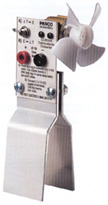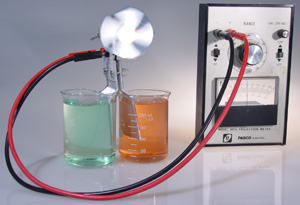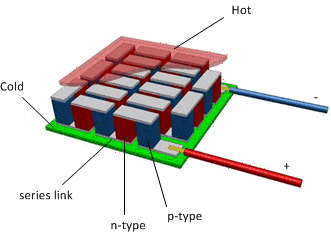Thermoelectric Converter
Materials:
- Two beakers containing hot and cold water
- Thermoelectric converter
- OHP ammeter
Demo:
The thermoelectric converter produces an electric potential from a temperature difference. Place the Thermoelectric converter such that each end is in a beaker of water, one with hot water and the other with cold water. If the temperature difference is great enough, the fan will start to spin and the ammeter will measure the generated current. This is all possible due to the Seebeck effect.
Seebeck Effect:
The Seebeck effect is the electrical phenomenon that relates a temperature difference to a generated voltage. Two wires of different conducting metals are joined at each end, creating a loop. An electrical potential is generated by the thermal differences between the two junctions of the conductors using the following relationship.
Where V is the generated voltage, T is the temperature difference, and S is the Seebeck coefficient, a property of the conductors that defines how efficiently the temperature difference converts to a generated voltage.
The basic principle of the Seebeck effect is that as heat is added to one end of each conductor, the electrons or protons, depending on the material, in the heated end become more excited and start to move to the cool end of the wire, creating a voltage difference. Figure 1 shows a material in which the electrons move from the hot end to the cold end, called an “n-type” conductor. “P-type” conductors work in a similar way, but the protons, rather than the electrons, move from the hot end to the cold end.
Using a combination of “n-type” and “p-type” conductors allows for the highest efficiency of transferring a heat difference into a voltage difference as seen in figure 2.
Figure 3 shows a diagram of many “n-type” and “p-type” conductors in series. A component with this setup can be seen in the thermoelectric converter demo between the two large metal plates, depicted in figure 4. These large metal plates act solely as thermal conductors while all the voltage generation is done in this small component.
This effect of generating a voltage through a temperature gradient can also be reversed, called the Peltier Effect.
Peltier Effect:
The Peltier effect is the opposite of the Seebeck effect where a current is provided to a thermoelectric converter to induce a temperature difference where one junction of the conductors is heated while the other is cooled. Interestingly, reversing the direction of the applied current reverses the induced heating or cooling from each junction. This is how modern air conditioning units operate.
Thermocouple
![]()
In a thermocouple, two dissimilar metals are joined to generate voltage that is related to the difference in temperature between the measuring junction and the reference junction (connection to the measuring device). Operating just like the thermoelectric converter, the thermocouple uses the Seebeck effect to generate a voltage which is converted to a corresponding temperature.
Written by: Finn Amend





